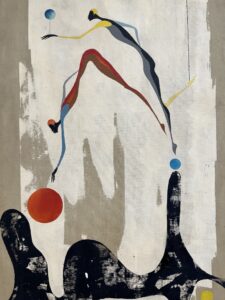Join us for an opening reception to celebrate and kick off our summer exhibitions!
In a world rich with diverse cultures and histories, the concept of belonging and homeplace holds profound significance. Within the tapestry of human experiences, one thread stands out with resilience, creativity, and an indomitable spirit – the Black cinematic experience. SSCAC is debuting the ‘Black Light Cinema Project’ to explore the intricate interconnectedness of Black life through new media and film. This inaugural iteration explores themes of belonging, homeplace, and identity, while celebrating the vibrancy of our urban landscapes, partnered alongside our 2nd floor Cortor gallery exhibition ‘Homecoming: Black Craft & Design in Chicago’.
At its core, ‘Black Light Cinema Project’ seeks to dismantle conventional notions of homeplace and embrace a more nuanced understanding through the exhibiting of the underrepresented medium of film in art space. We invite visitors to venture beyond the physical spaces we call home, encouraging them to delve into the emotional, spiritual, and ancestral landscapes that define our sense of belonging. Through ongoing screenings of film shorts, we offer a multifaceted exploration of the Black experience, revealing the complex interplay of history, memory, and identity.
Featured Artists: Jada Amina , zakkiyyah najeebah dumas-o’neal, Cameron Granger , Paige Taul, and cai thomas
This exhibition is curated by SSCAC Exhibitions Manager and Curator Lola Ayisha Ogbara.

Cameron Granger. Heavy as Heaven. 2022, 11 mins, 3-channel, Sound, Digital file.
‘Homecoming: Black Craft & Design’ in Chicago utilizes the varying practices of several Black craft artists in Chicago working in the mid to late 20th century and pairs their work with historical archival materials from the socio-political movements in the city during the Black Arts Movement, of the 60’s and 70’s.
Chicago is internationally known as a diverse cultural landscape that is rooted in segregation and discrimination, but this exhibition aims to explore how studio craft artists are using their practices and connections to spaces like the South Side Community Art Center to explore these themes. This exhibition seeks to present the complex multivalent histories of Black artists with varying connections to the South Side Community Art Center during its early years in the mid-twentieth century. These artists all in some way play with the performative presentations of body and self through creating ambiguous figures or forms. These artists have explored complex themes of Black cultural representation, concepts around object functionality and performativity, issues in presentation of self through objects, and methods of socio-cultural identity making through creative expression.
The exhibition will present the biographical backgrounds of the artists included while exploring how they technically executed their works (both professionally and personally), as well as reflecting on the conceptual subjects that fueled their practices.
Featured Artists: Elizabeth Catlett, Irene Clark, Bobbe Cotton, Jeremiah Drake, Espi Eph, Clinton Foreman, Eselean Henderson, William McBride, Geraldine McCullough, El Roi Parker, Marva Jolly Pitchford, Allen Stringfellow, Teresa Staats, and Bill Walker.
This exhibition is curated by SSCAC Archives and Collections Manager LaMar Gayles Jr.





